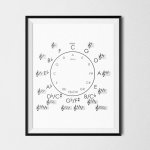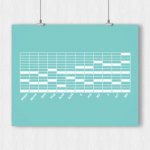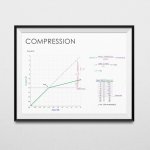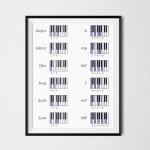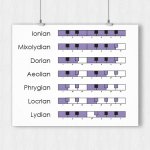let's look at this logically
| Major Chord | Key colour used |
|---|
| C/F/G | W-W-W |
| A/D/E | W-B-W |
| B | W-B-B |
| Bb/A# | B-W-W |
| Ab/G#/Db/C#/Eb/D# | B-W-B |
| Gb/F# | B-B-B |
[
whilst the semitones remain constant in each of the major chords the keys depressed on a keyboard do not remain the same colour and therefore the hand shape changes (whether you like it or not, this is the reality when teaching chord shapes). The same is true of the other chord instrument, the guitar: I know of 6 shapes for major chords simply playing in open position or at the first or second fret, some of these may be explained as movable versions of the others but that still leaves us with three valid movable shapes for a major chord - the internal structure is different for each of these shapes but they all spell a major chord when reduced to their fundamental note names.
- to someone who knows what they are doing, this difference to the picture of three white keys being used to play a major chord is easily understood and compensated for
- to a person new to playing the keys, this difference is not obvious and so they will possibly use the three white keys possibility for all chords that start on a white key note and apply the perverse but understandable logic that chords that start on a black must use all black keys this would lead to the following erroneous spellings of major chords
D - DFA which is D minor
E - EGB which is E minor
A - ACE which is A minor
B - BDF which is B diminished
Bb - Bb-Db-F# which is minor#5 or Gb in 1st inversion
Db - Db-F#-Ab which is Db sus4 (Db-Gb-Ab)
Eb - Eb-Gb-Bb which is Eb minor
Ab - Ab-C#-Eb which is Ab sus4 (Ab-Db-Eb)
Whilst you might think that the above scenario does not meet common sense thinking it is exactly what new musicians/non-musicians do do when asked to work with chords given a few simple ideas: they use the existing model to generate new ideas and then wonder why it doesn't sound right and then resolve that music is too difficult because it is not "logical"
simplicity is not always the hallmark of accuracy or great design. Ultimately, a musician will not ever refer to you chart or mine simply because they have memorised the structures.
If you remove the complexity of individual chords to present a white notes only view of major chords (and similar views of each other chord type) then you remove the ability for that person to actually confront the logical realities of why the different shapes are indeed major chords (they have to recognise the number of semitones in play in each shape) - the multiplicity of shapes is the reality and no amount of clever design rhetoric will remove that.
ps major chords are spelled as 0-4-7 in terms of their semitones or 1-3-5 in terms of their active notes - a minor chord is defined as 0-3-7 in terms of its semitones or 1-b3-5 in terms of their active notes
